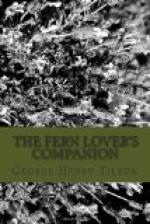(3) NEW YORK FERN
Aspidium noveboracense. THELYPTERIS NOVEBORACENSIS Dryopteris noveboracensis. Nephrodium noveboracense
Fronds pinnate, tapering both ways from the middle. Pinnae lanceolate, pinnatifid, the lowest pairs gradually shorter and deflexed. Veins simple. Indusium minute and beset with glands.
[Illustration: New York Fern. Aspidium noveboracense]
Very common in woodlands, preferring a dryer soil than the marsh fern. August. The fronds are pale green, delicate and hairy beneath along the midrib and veins.
[Illustration: Sori of New York Fern (From Waters’s “Ferns,” Henry Holt & Co.)]
[Illustration: New York Fern. Aspidium noveboracense]
When bruised its resinous glands give out a pleasing, ferny odor. This species can be distinguished from every other by the greatly reduced pinnae at its base. Throughout North America east of the Mississippi.
THE BEECH FERNS
The beech ferns are often classed with the polypodies, because, like them, they have no indusium; but in other ways they are more akin to the wood ferns. Their stipes are not jointed to the root stock, nor are their sori at the ends of the veins as in the polypodies. We here place them with the wood ferns, retaining the familiar name Phegopteris but giving THELYPTERIS as a synonym. The fruit-dots are small, round and naked, borne on the back of the veins below the apex. Stipe continuous with the rootstock. Veins free. (The name Phegopteris in Greek means oak or beech fern.)
(1) OAK FERN
Phegopteris dryopteris. THELYPTERIS DRYOPTERIS
Fronds glabrous, broadly triangular, ternate, four to seven inches broad, the divisions widely spreading, each division pinnate at the base. Segments oblong, obtuse, entire or toothed. Fruit-dots near the margin. Rootstock slender and creeping from which fronds are produced all summer, in appearance like the small, ternate divisions of the bracken.
This dainty fern has fronds of a delicate yellow-green, “the greenest of all green things growing.” Its ternate character is shown even in the uncoiling of the fronds, the three round balls suggesting the sign of the pawnbroker. The parts of the oak fern develop with great regularity, each pinna, pinnule and lobe having another exactly opposite to it nearly always. In rocky woods, common northward; also in Virginia, Kansas and Colorado. A fine species for cultivation at the base of the artificial rockery.
[Illustration: Oak Fern. Phegopteris Dryopteris]
(2) THE NORTHERN OAK FERN
Phegopteris Robertiana. Phegopteris calcarea
THELYPTERIS ROBERTIANA
Resembles the oak fern, but with fronds rather larger, especially the terminal segment; also more rigid and coarser in appearance. Stalks and fronds minutely glandular beneath. Lower pinnules of the lateral divisions scarcely longer than the others. Often called “Limestone Polypody,” the beech ferns having formerly been classed with the polypodies. Britton and Brown designate it as the “Scented Oak Fern.” Canada and the northwestern states. Rare.




